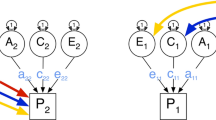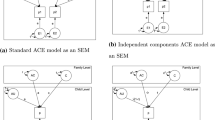Abstract
We describe the implementation of multivariate models of familial resemblance with the Mx package. The structural equation models allow for the effects of assortative mating, additive and dominant genes, common and specific environment, and both genetic and cultural transmission between generations. Two approaches are compared: a correlational one based on Fulker and a factor model described by Phillips and Fulker. Both are illustrated by application to published data on social fears and fear of leadership measured in monozygotic and dizygotic twins and their parents. In the example data, genetic dominance yields a more parsimonious explanation of the data than does cultural transmission, although neither is needed to obtain a good fit to the data. A model of reduced genetic correlation between generations also fits the data but has inherent limitations in this sample. Extensions to sex-limitation and more complex models are discussed.
Similar content being viewed by others
References
Akaike, H. (1987). Factor analysis and AIC.Psychometrika 52:317–332.
Cardon, L. R., Fulker, D. W., and Jöreskog, K. G. (1991). A LISREL model with constrained parameters for twin and adoptive families.Behav. Genet. 21:327–350.
Carey, G. (1986). A general multivariate approach to linear modeling in human genetics.Am. J. Hum. Genet. 39:775–786.
Eaton, W. W., Dryman, A., and Weissman, M. M. (1991). Panic and phobia. In Robins, L. N. and Regier, D. A. (eds.),Psychiatric Disorders in America, Free Press, New York.
Eaves, L. J., Eysenck, H. J., and Martin, N. G. (1989a).Genes, Culture and Personality: An Empirical Approach, Oxford University Press, London.
Eaves, L. J., Fulker, D. W., and Heath, A. C. (1989b). The effects of social homogamy and cultural inheritance on the covariances of twins and their parents.Behav. Genet. 19:113–122.
Eaves, L. J., Last, K. A., Young, P. A., and Martin, N. G. (1978). Model-fitting approaches to the analysis of human behavior.Heredity 41:249–320.
Eaves, L. J., Long, J., and Heath, A. C. (1986). A developmental change in quantitative phenotypes applied to cognitive development.Behav. Genet. 16:143–162.
Eaves, L. J., Silberg, J. L., Meyer, J. M., Hewitt, J. K., and Neale, M. C. (1993). Latent class models for genetically informative data.Behav. Genet. 23:5–19.
Fisher, R. A. (1918). The correlation between relatives on the supposition of Mendelian inheritance.Translat. Roy. Soc. Edinburgh 52:399–433.
Fisher, R. A. (1958).The Genetical Theory of Natural Selection, 2nd ed., Dover, London.
Fulker, D. W. (1982). Extensions of the classical twin method. InHuman Genetics, Part A: The Unfolding Genome, Alan R. Liss, New York, pp. 395–406.
Fulker, D. W. (1988). Genetic and cultural transmission in human behavior. In Weir, B. S., Eisen, E. J., Goodman, M. M., and Namkoong, G. (eds.),Proceedings of the Second International Conference on Quantitative Genetics, Sinauer, Sunderland, MA, pp. 318–340.
Geer, J. H. (1965). The development of a scale to measure fear.Behav. Res. Ther. 3:45–53.
Heath, A. C., and Eaves, L. J. (1985). Resolving the effects of phenotype and social background on mate selection.Behav. Genet. 15:15–30.
Heath, A. C., Eaves, L. J., and Martin, N. G. (1989). The genetic structure of personality. iii. Multivariate genetic item analysis of the epq scales.Personal. Indiv. Diff. 10:877–888.
Jencks, C. (1972).Inequality: A Reassessment of the Effect of Family and Schooling in America, Basic Books, New York.
Kendler, K. S. (1988). Indirect vertical cultural transmission.Am. J. Psychiat. 145:657–665.
Kendler, K. S., Heath, A. C., Martin, N. G., and Eaves, L. J. (1987). Symptoms of anxiety and symptoms of depression: Same genes, different environments?Arch. Gen. Psychiat. 44:451–457.
Kendler, K. S., Neale, M. C., Kessler, R. C., Heath, A. C., and Eaves, L. J. (1992). The genetic epidemiology of phobias in women: The interrelationship of agoraphobia, social phobia, situational phobia and simple phobia.Arch. Gen. Psychiat. 49:273–281.
Lange, K., Westlake, J., and Spence, M. A. (1976). Extensions to pedigree analysis. III. Variance components by the scoring method.Ann. Hum. Genet. 39:485–491.
Marks, I. M. (1987).Fears, Phobias and Rituals, Oxford University Press, London.
McArdle, J. J., and Goldsmith, H. H. (1990). Alternative common-factor models for multivariate biometric analyses.Behav. Genet. 20:569–608.
Neale, M. C. (1985).Biometrical Genetic Analysis of Human Individual Differences, Unpublished doctoral dissertation, University of London, London.
Neale, M. C. (1987). Evidence for cultural transmission and assortative mating for a measure of conservatism in a sample of twins and their parents.Behav. Genet. 17:633.
Neale, M. C. (1991).Mx: Statistical Modeling, Department of Human Genetics, Medical College of Virginia, Richmond.
Neale, M. C., and Cardon, L. R. (1992).Methodology for Genetic Studies of Twins and Families, Kluwer Academic, New York.
Neale, M. C., and Fulker, D. W. (1984). A bivariate path analysis of fear data on twins and their parents.Acta Genet. Med. Gemellol. 33:273–286.
Neale, M. C., Walters, E. W., Heath, A. C. Kessler, R. C., Pérusse, D., Eaves, L. J., and Kendler, K. S. (1994). Depression and parental bonding: Cause, consequence, or genetic covariance?Genet. Epidemiol. (in press).
Parker, G. (1981). Parental reports of depressives: An investigation of several explanations.J. Affect. Disord. 3:131–140.
Phillips, K., Fulker, D., and Rose, R. (1987). Path analysis of seven fear factors in adult twin and sibling pairs and their parents.Genet. Epidemiol. 4:345–355.
Phillips, K., and Fulker, D. W. (1989). Quantitative genetic analysis of longitudinal trends in adoption designs with application to IQ in the Colorado Adoption Project.Behav. Genet. 19:621–658.
Phillips, K., and Matheny, A. P. (1990). Quantitative genetic analysis of longitudinal trends in height: Preliminary results from the louisville twin study.Acta Genet. Med. Gemellol. 39:143–163.
Rice, J., Cloninger, C. R., and Reich, T. (1978). Multifactorial inheritance with cultural transmission and assortative mating. I. Description and basic properties of the unitary models.Am. J. Hum. Genet. 30:618–643.
Rose, R. J., and Ditto, W. B. (1983). A developmental-genetic analysis of common fears from early adolescence to early childhood.Child Dev. 54:361–368.
Seligman, M. E. P. (1970). On the generality of the laws of learning.Psychol. Rev. 77:406–418.
Truett, K. L., Walters, E. E., Eaves, L. J., Heath, A. C., Hewitt, J. K., Meyer, J. M., Silberg, J. L., Neale, M. C., Martin, N. G., and Kendler, K. S. (1994). A model system for analysis of family resemblance in extended kinships of twins.Behav. Genet. (in press).
van Eerdewegh, P. (1982).Statistical Selection in Multivariate Systems with Applications in Quantitative Genetics, Unpublished doctoral dissertation, Washington University, St. Louis, MO.
Vogler, G. P. (1985). Multivariate path analysis of familial resemblance.Genet. Epidemiol. 2:35–53.
Young, P. A., Eaves, L. J., and Eysenck, H. J. (1980). Intergenerational stability and change in the causes of variation in personality.Personal. Indiv. Diff. 1:35–55.
Author information
Authors and Affiliations
Rights and permissions
About this article
Cite this article
Neale, M.C., Walters, E.E., Eaves, L.J. et al. Multivariate genetic analysis of twin-family data on fears: Mx models. Behav Genet 24, 119–139 (1994). https://doi.org/10.1007/BF01067816
Received:
Accepted:
Issue Date:
DOI: https://doi.org/10.1007/BF01067816




